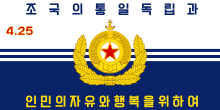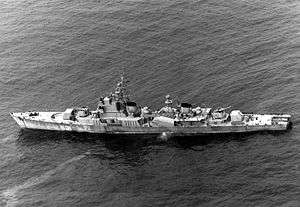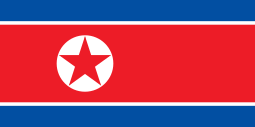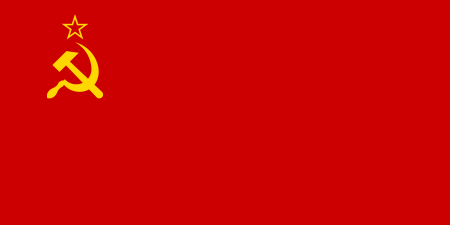Korean People's Navy
The Korean People's Army Naval Force (KPANF; Korean: 조선인민군 해군; Hanja: 朝鮮人民軍 海軍; Chosŏn-inmingun Haegun; lit. '"Korean People's Military Navy"') or the Korean People's Navy (KPN), is the naval service branch of the Korean People's Army, which contains each branch of the North Korean armed forces.
| Korean People's Army Naval Force | |
|---|---|
| 조선인민군 해군 Chosuninmingun Haegun | |
 The flag of the North Korean navy | |
| Founded | June 5, 1946 |
| Country | |
| Allegiance | |
| Type | Navy |
| Size | 60,000 personnel |
| Part of | |
| Fleet | 70 submarines 456 landing craft 3 frigates 14 corvettes 30 mine countermeasure vessels 30 missile boats 247 torpedo boats 191 patrol boats |
| Engagements | Korean War |
| Commanders | |
| Commander-in-chief | Fleet Admiral Li Yong-ju[2] |
| Insignia | |
| Ensign |  |
| Former flag | .svg.png) |
 |
| Components |
|---|
| Korean People's Navy |
| History |
| History of the Korean People's Navy |
| Ships |
| Current Fleet |
| Naval Bases |
| Personnel |
| Senior Officers |
There are some 780 vessels including 70 midget submarines (including the Yono-class submarine and Sang-O-class submarine), 20 Romeo-class submarines, and about 140 air cushioned landing craft.[3]
The North Korean navy is considered a brown water navy and operates mainly within the 50 kilometer exclusion zone. The fleet consists of east and west coast squadrons, which cannot support each other in the event of war with South Korea. The limited range of most of the antiquated and derelict vessels means that, even in peacetime, it is virtually impossible for a ship on one coast to visit the other coast.
History
The KPN was established on June 5, 1946.[4]
Naval engagements of the Korean People's Army Naval Force
- Landing operation near Kangnung and Samcheok (June 25–26, 1950)
- Battle of Chumonchin Chan (July 2, 1950)
- Battle of Haeju (September 10, 1950)
- Pueblo incident (January 23, 1968)
- Gangneung Infiltration (September 17, 1996 - November 5, 1996)
- Battle of Yosu (December 17–18, 1998)
- First Battle of Yeonpyeong (June 9–15, 1999)
- Battle of Amami-Ōshima (December 22, 2001)
- Second Battle of Yeonpyeong (June 29, 2002)
- Battle of Daecheong (November 10, 2009)
- ROKS Cheonan sinking (March 26, 2010)
Reported 2016 submarine sinking
On March 11, 2016 CNN and the U.S. Naval Institute News reported that unnamed US officials believed a North Korean submarine had been lost at sea in the Sea of Japan. According to reports, the U.S. military had been observing the submarine when it "stopped" before the North Korean navy was observed searching the area by American satellites, aircraft and ships.[5][6]
Organization
According to the Defense Intelligence Agency, the 146,000-man North Korean navy (NKN) is primarily a coastal navy. The NKN is organized into two fleets: the East Coast Fleet, with eight operational commands, and the West Coast Fleet, with five operational commands. The East Coast Fleet is headquartered at Toejo Dong, with major bases at Najin and Wonsan.[7]
The West Coast Fleet is headquartered at Nampo, with major bases at Pipagot and Sagon Ni. Numerous smaller naval bases are located along both coasts. The fleets do not exchange vessels because geographical limitations make mutual support almost impossible. The NKN does not have a Marine Corps or naval aviation capabilities. Amphibious operations are conducted by SOF units in addition to naval personnel.[7]
According to South Korea's National Intelligence Service (in 1999):
The DPRK Navy is divided into East Sea (10 squadrons) and West Sea fleets (6 squadrons) with a total manpower of 148,000.
North Korea's fleet consist of approximately 630 combat vessels (Patrol craft, guided missile boats, torpedo boats, fire support craft, destroyers, frigates, corvettes, and three cruisers), 100 submarines, and 340 support craft (landing craft, hovercraft). As with the ground forces, 60% of the vessels are stationed near the demarcation line.
North Korea has constructed and is operating up to 130 hovercraft, each one capable of transporting a special forces platoon and operating freely in difficult terrain such as tidal flats, and able to be used for multiple landings by special forces troops at the onset of any war.[8]
The Times puts the total in 2009 at "420 warships and 60 submarines."[9]
The annual report of North Korea's military capabilities by the U.S. Department of Defense, released in early 2014, identified the North Korean Navy's strength at 60,000 personnel, 70 submarines, 420 gun boats, 260 amphibious landing craft, 30 mine warfare vessels, and 30 support ships.[10]
Inventory

Most NKN vessels are small patrol-size craft unable to operate over 50 nautical miles (NM) from the coast but capable of policing the DPRK's territorial waters. The navy's numerous amphibious craft and midget submarines are intended to clandestinely insert SOF units into the ROK. The DPRK also maintains coastal defense artillery and missile sites. Coastal defense artillery includes 122 mm, 130 mm, and 152 mm systems. Land-based coastal defense missiles include the SSC-2B SAMLET, CSSC-2 SILKWORM, and CSSC-3 SEERSUCKER.[7]
The NKN's most capable weapons systems are their approximately 43 guided-missile patrol boats equipped with the SS-N-2A STYX antiship missile (or its Chinese version, the CSS-N-1 SCRUBBRUSH). Though their small size limits operations to coastal waters and calm seas, they have a capability to quickly respond to Combined Forces Command (CFC) shipping approaching the coast. The NKN has 12 OSA-1 guidedmissile patrol boats, 10 DPRK versions of the OSA-1 called the SOJU, and 19 other fast-attack missile craft; the OSA and SOJU are all equipped with four CSS-N-1 missile launchers. The missiles have a maximum range of 25 NM and carry radar or infrared homing seekers.[7]
The largest part of the NKN consists of small combatants, including torpedo boats, patrol boats, patrol craft, fast attack craft, and small amphibious landing craft. Of the approximately 200 torpedo boats, nearly half are DPRK-built. Most are equipped with 25 mm to 37 mm guns. The DPRK built at least 62 CHAHO fire-support patrol units. This unique vessel has a multiple rocket launcher in the center of its deck to provide fire support to ground troops or attack surface ships.[7]
The DPRK's attack submarine inventory is estimated to include 4 former Soviet Whiskey class submarine, 22 Chinese ROMEO Class submarines, and DPRK-built ROMEO Class submarines. The WHISKEYs, acquired in the 1960s, can carry 12 torpedoes or 24 mines. Shortly after delivering four ROMEOs in the early 1970s, China helped the DPRK start its own ROMEO construction program. The ROMEOs are well equipped, have an improved sonar, and can carry 14 torpedoes or 28 mines.[7]
To date, the DPRK has indigenously produced over 200 personnel landing craft. This includes approximately 100 NAMPO personnel landing craft based on a former Soviet P-6 torpedo boat hull. The NAMPO has a maximum speed of 40 knots (74 km/h) and a radius of 335 nmi (620 km) at 28 knots (52 km/h). The NAMPOs provide a limited amphibious capability, each carrying up to 30 troops with a basic combat load. Amphibious assaults against CFC probably would be small, clandestine landings involving two to six NAMPO craft; CHAHO or other naval craft could provide fire support. Other amphibious craft include 8 HANTAE medium landing ships, which can carry 3 to 4 light tanks, and approximately 125 KONG BANG amphibious hovercraft.[7]
The DPRK has a credible mine warfare capability. There are numerous small surface ships that are capable of delivering mines within both the navy and civilian sectors. Mines will be used to defend against amphibious assaults, defend strategic ports, and provide seaward flank protection for land forces. Defensive mine fields will be monitored by coastal observation teams and radar, and they will be supported by well emplaced artillery and missile batteries. This will make close approach and mine clearing operations extremely hazardous. DPRK has a large inventory of older technology mines, significant historical experience with their effectiveness, and, most importantly, the willingness to use them.[7]
The latest bi-annual report of North Korea's military capabilities by the ROK's Ministry of National Defense, released in 2018, KPN inventory is estimated at 430 combat ships, 250 landing crafts, 20 mine layers, 40 support ships, 70 submarines.[11]
Modernization
For years, the Korean People's Army Naval Force stagnated with a number of ships becoming old and weapons turning obsolete, this peaked with an accident during drills, when the Chosun Ilbo reported that in mid-October 2013, one of the DPRK's Hainan Class submarine chasers and one of its smaller patrol boats sank during maneuvers in the Sea of Japan with an unknown loss of life.[12]
After 2013 surfaced on western analysis, a number of upgrades and new classes in service with the Navy appeared: most of this modernization's program is left to speculation and analysis of satellite images, due the absence of details released by North Korea.
South Korea reported that North Korea has built a new high-speed, wave piercing craft to deploy troops as part of efforts to enhance infiltration capabilities by sea. Called a Very Slender Vessel (VSV), it is cylindrical with a small cross section to pierce through waves at high speed. It is 10–15 m (33–49 ft) long and can carry a small number of special forces at over 100 km/h (62 mph; 54 kn), compared to air-cushion vehicles than can travel at 96 km/h (60 mph; 52 kn). VSVs are considered one of the most threatening craft in the Korean People's Army Naval Force for their commando infiltration capabilities onto border islands.[13]
North Korea has built two helicopter frigates to enhance its anti-submarine warfare capabilities. Construction began in 2006-07 and launched in 2011-12, but it is unknown if they have been commissioned and are in service. The frigates are estimated to be 76 m (249 ft) long and 11 m (36 ft) wide, with a 29 m × 11 m (95 ft × 36 ft) flight deck and a displacement of 1,300 tonnes (1,300 long tons; 1,400 short tons). Armament is believed to include 4 RBU 1200 ASW rocket launchers, a 30 mm CIWS, and possibly the C-802 missile. Its main weapon is either a Mil Mi-4 or Mil Mi-14 helicopter.[14]
In June 2014, propaganda pictures from the North Korean state TV briefly showed one of the newly built patrol SES vessels, firing a Kh-35 anti-ship cruise missile.[15] Despite some initial doubts over the nature of the missile, they appear to be built in North Korea and have been exported to Myanmar (earlier speculations believed they were imported from Myanmar). The missile gives the KPN the potential to considerably improve its anti-surface missiles.[15] In addition to the missiles, the SES vessels show a reversed-engined gun of 76 mm (3 in).[16][17][18] Kh-35 missiles were also installed during 2014 on one of the two old Najin-class frigates (replacing the previous obsolete KN-01 missiles): the ship also received upgrades in gunnery.[19]
In autumn 2014, satellite images identified a newly built submarine of a new class: with a length of 67metres, it's the largest-ever submarine built so far by North Korea, it's believed to be related to older Yugoslavian projects, but if mass-built could potentially replace the aging fleet of Romeo submarines.[20]
In spring 2015, the new submarine was observed at sea during trials, paired with a test of the KN-11 missile.[21]
Structure
Bases
The KPN has 20 bases split between the two coasts (Sea of Japan and Yellow Sea) with major and minor bases:[22]
West Sea Fleet
The western fleet has approximately 300 watercraft (administrative, operational and logistic support), berthing facility for Yellow Sea Fleet; home to shipyard and sub base
- Ch'o-do: small support base and home to Sqron 9 (Fast Attack Craft)
- Haeju: major naval base and ship repair facility close to Demarcation Line
- Kwangyang-ni
- Pip'a-got: limited operational and logistical support to patrol craft; also home to some subs
- Sagot (Sagon-ni): home to Sqron 8
- Sunwi-do
- Tasa-ri: small naval base
- Yomju (Yomju-gun)
- Yongwi-do
East Sea Fleet
The eastern fleet has approximately 470 ships and small craft.
- Ch'aho (Ch'aho-nodongjagu) - one of two sub bases in North Korea
- Ch'angjon: home base for smaller patrol boats
- Mayangdo: operation and logistical support for submarines, antisubmarine craft, and patrol craft; one of 2 sub bases in North Korea
- Mugyepo: base for patrol boats, landing crafts and frigate
- Puam Dong: base for patrol boats, landing craft
- Puam-ni: small base for landing craft and patrol boats
- Rason (Rajin): major naval operating and training centre
- Songjon-Pando: support base for patrol and missile boats; part of the larger Wonsan naval/maritime complex
- T'oejo-dong: base for patrol boats and 1 frigate
- Wonsan (Munch'on): large maritime complex and HQ for the eastern fleet
Some ships are domestically built at Wonsan and Nampho shipyards. Southern bases on each coasts are used to organize infiltrations into South Korea and Japan.
Weapons
- MSI Yukto I/II countermeasures





















- SM-4-1


Ranks and uniforms
Ranks
The Korean People's Army Navy has five categories of ranks; flag officers, senior officers, junior officers, petty officers, and seamen.
Enlisted ratings
| Equivalent NATO code | OR-9 | OR-8 | OR-7 | OR-6 | OR-5 | OR-4 | OR-3 | OR-2 | OR-1 | |||||||||||||||||||||||||||
|---|---|---|---|---|---|---|---|---|---|---|---|---|---|---|---|---|---|---|---|---|---|---|---|---|---|---|---|---|---|---|---|---|---|---|---|---|
(Edit) |
.svg.png) |
.svg.png) |
.svg.png) |
.svg.png) |
.svg.png) |
.svg.png) |
.svg.png) |
.svg.png) |
No equivalent | |||||||||||||||||||||||||||
| T'ŭkmu-sangsa 특무상사 |
Sangsa 상사 |
Chungsa 중사 |
Hasa 하사 |
Sanggŭp-pyŏngsa 상급병사 |
Chungŭp-pyŏngsa 중급병사 |
Hagŭp-pyŏngsa 하급병사 |
Chŏnsa 전사 | |||||||||||||||||||||||||||||
| Master chief petty officer | Senior Chief Petty Officer | Chief Petty Officer | Petty Officer 1st Class | Petty Officer 2nd Class | Petty Officer 3rd Class | Seaman | Seaman Recruit | |||||||||||||||||||||||||||||
Officers
| Equivalent NATO code | OF-10 | OF-9 | OF-8 | OF-7 | OF-6 | OF-5 | OF-4 | OF-3 | OF-2 | OF-1 | OF(D) and student officer | |||||||||||||||||||||||||
|---|---|---|---|---|---|---|---|---|---|---|---|---|---|---|---|---|---|---|---|---|---|---|---|---|---|---|---|---|---|---|---|---|---|---|---|---|
(Edit) |
No equivalent |  |
 |
 |
 |
 |
 |
 |
 |
 |
 |
 |
 |
No equivalent | ||||||||||||||||||||||
| Taejang (대장) |
Sangjang (상장) |
Chungjang (중장) |
Sojang (소장) |
Daechwa (대좌) |
Sangjwa (상좌) |
Chungjwa (중좌) |
Sojwa (소좌) |
Taewi (대위) |
Sangwi (상위) |
Chungwi (중위) |
Sowi (소위) | |||||||||||||||||||||||||
Marshals
Occasionally KPA Navy officers are promoted above Fleet Admiral. In that case, they wear army-style uniform, since ranks from Vice-Marshal and above are not divided into army, navy and air force.[26]
| Supreme commanders | Marshals | |||
|---|---|---|---|---|
| Ranks in Korean | Tae wonsu 대원수 | Konghwaguk Wonsu 공화국원수 | Wonsu 원수 | Ch'asu 차수 |
| Ranks | Generalissimo | Marshal of the DPRK | Marshal of the KPA | Vice Marshal |
Uniforms
The naval officers wear black jackets and pants with blue shirt and dark tie underneath. Their peaked caps are from the Soviet era. In summer jackets are white in the full dress uniform.
Junior ratings and seamen wear white shirts (in the summer) or navy blue shirts (in the winter) with black/white jackets and slacks (skirts for women) and wear sailor caps.
All ranks wear shoulder and collar insignia while all officers, flag officers included, wear sleeve insignia as well in their service blue uniforms.
Anniversary
At first, an ordinance issued by the Supreme People's Assembly on June 3, 1972 designated August 28 as the Navy Day, claiming that the first leader Kim Il-sung organized the Torpedo Unit on that date of 1949. In 1993 the North Korean authorities changed it to June 5, as its "Maritime Security Corps" were organized on June 5, 1946.
See also
- Northern Limit Line
- Korean Demilitarized Zone
- Defense Industry of North Korea
- Republic of Korea Armed Forces
- Republic of Korea Navy
- Korean People's Army
- Korean People's Army Ground Force
- Korean People's Army Air and Anti-Air Force
References
- "North Korean military takes oath of loyalty". www.enca.com.
- Li Yong-Ju was promoted as the North Korean naval commander captain (Korean) Retrieved April 6, 2016.
- http://www.mod.go.jp/e/publ/w_paper/pdf/2016/DOJ2016_1-2-2_web.pdf
- "The People's Army in the Making". Federation of American Scientists Official Website. Retrieved September 16, 2007.
- "First on CNN: U.S. says North Korean submarine missing"
- "U.S. Official: North Korean Submarine is Missing, Presumed Sunk"
- "NORTH KOREA COUNTRY HANDBOOK (PDF Format)" Archived 2011-07-18 at the Wayback Machine. Defense Intelligence Agency Official Website. Retrieved August 23, 2012.

- "The KPA: Troops & Equipment". Federation of American Scientists Official Website. Retrieved September 16, 2007.
- "Extravagant monuments cannot hide the grim reality of North Korea". Timesonline.co.uk. 2012-04-27. Retrieved 2012-06-18.
- http://www.defense.gov/pubs/North_Korea_Military_Power_Report_2013-2014.pdf
- http://www.mnd.go.kr/user/mnd/upload/pblictn/PBLICTNEBOOK_201901160236460390.pdf
- Chosun Ilbo, 4 November 2013
- N. Korea builds new high-speed infiltration boat - Koreatimes.co.kr, 23 March 2014
- New North Korean Helicopter Frigates Spotted - 38north.org, 15 May 2014
- Joseph S. Bermudez (8 February 2015). "The Korean People's Army Naval Force Tests New Anti-ship Cruise Missile". 38 North. U.S.-Korea Institute, Johns Hopkins University School of Advanced International Studies. Retrieved 19 May 2015.
- Oryx. "Oryx Blog". Retrieved 24 December 2014.
- "When A Cruise Missile Is Just A Cruise Missile - 38 North: Informed Analysis of North Korea". Retrieved 24 December 2014.
- "Translating a Noun into a Verb Pyongyang Style: The Case of North Korea's New Cruise Missile - 38 North: Informed Analysis of North Korea". Retrieved 24 December 2014.
- "KPA Navy flagship undergoing radical modernization". Retrieved 24 December 2014.
- "The North Korean Navy Acquires a New Submarine - 38 North: Informed Analysis of North Korea". Retrieved 24 December 2014.
- "404: OK". www.hisutton.com.
- John Pike. "Naval Bases - North Korea". Globalsecurity.org. Retrieved 2012-06-18.
- http://www.kpajournal.com/storage/KPAJ-2-12.pdf
- "Imgur".
- N. Korea Unveils New Missile With Maximum Range of 130 Km - KBS.co.kr, 9 June 2014
- Tertitskiy, Fyodor (March 14, 2017). "North Korea's baffling personalized rank insignia, explained". NK News.